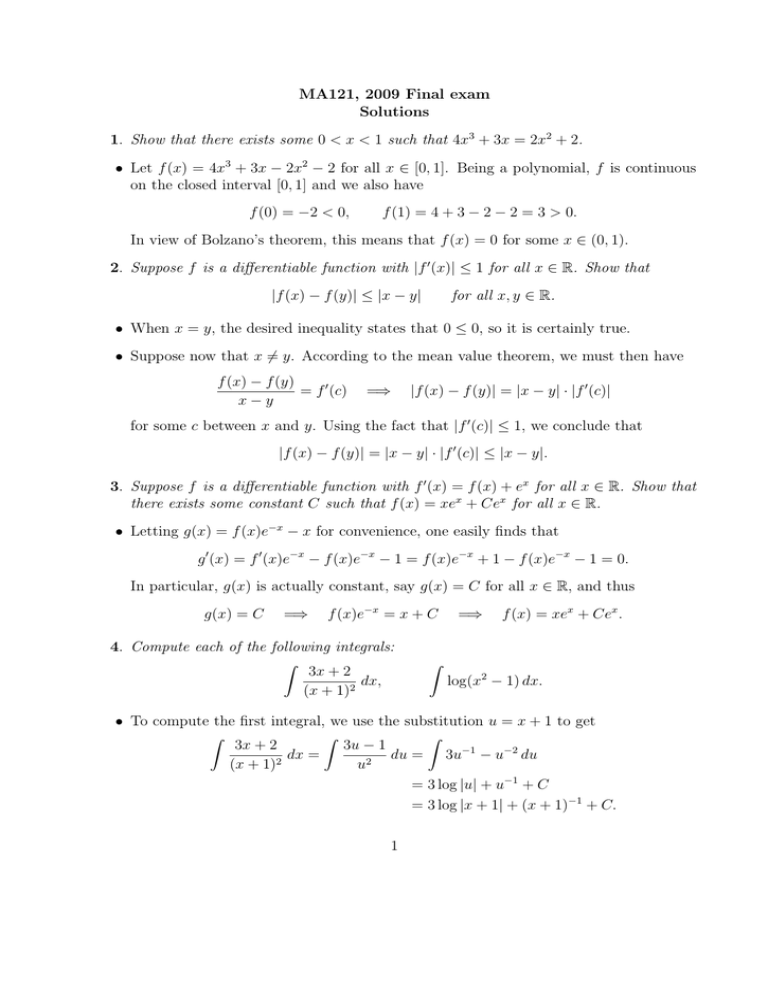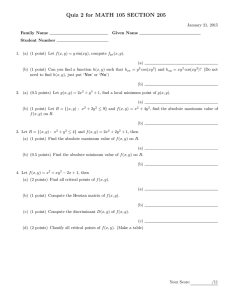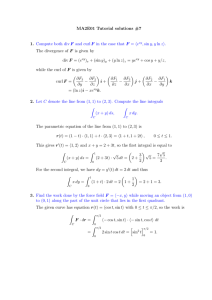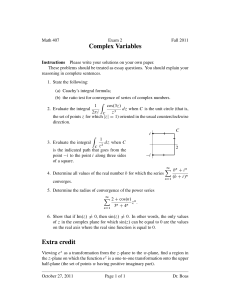MA121, 2009 Final exam Solutions 1 2
advertisement

MA121, 2009 Final exam
Solutions
1. Show that there exists some 0 < x < 1 such that 4x3 + 3x = 2x2 + 2.
• Let f (x) = 4x3 + 3x − 2x2 − 2 for all x ∈ [0, 1]. Being a polynomial, f is continuous
on the closed interval [0, 1] and we also have
f (0) = −2 < 0,
f (1) = 4 + 3 − 2 − 2 = 3 > 0.
In view of Bolzano’s theorem, this means that f (x) = 0 for some x ∈ (0, 1).
2. Suppose f is a differentiable function with |f ′ (x)| ≤ 1 for all x ∈ R. Show that
|f (x) − f (y)| ≤ |x − y|
for all x, y ∈ R.
• When x = y, the desired inequality states that 0 ≤ 0, so it is certainly true.
• Suppose now that x ̸= y. According to the mean value theorem, we must then have
f (x) − f (y)
= f ′ (c)
x−y
=⇒
|f (x) − f (y)| = |x − y| · |f ′ (c)|
for some c between x and y. Using the fact that |f ′ (c)| ≤ 1, we conclude that
|f (x) − f (y)| = |x − y| · |f ′ (c)| ≤ |x − y|.
3. Suppose f is a differentiable function with f ′ (x) = f (x) + ex for all x ∈ R. Show that
there exists some constant C such that f (x) = xex + Cex for all x ∈ R.
• Letting g(x) = f (x)e−x − x for convenience, one easily finds that
g ′ (x) = f ′ (x)e−x − f (x)e−x − 1 = f (x)e−x + 1 − f (x)e−x − 1 = 0.
In particular, g(x) is actually constant, say g(x) = C for all x ∈ R, and thus
g(x) = C
=⇒
f (x)e−x = x + C
4. Compute each of the following integrals:
∫
3x + 2
dx,
(x + 1)2
=⇒
f (x) = xex + Cex .
∫
log(x2 − 1) dx.
• To compute the first integral, we use the substitution u = x + 1 to get
∫
∫
∫
3x + 2
3u − 1
dx =
du = 3u−1 − u−2 du
(x + 1)2
u2
= 3 log |u| + u−1 + C
= 3 log |x + 1| + (x + 1)−1 + C.
1
• To compute the second integral, we integrate by parts to find that
∫
∫
2x2
2
2
log(x − 1) dx = x log(x − 1) −
dx.
x2 − 1
Using division of polynomials to simplify the rational function, we get
∫
∫
2x2
2
2x2
2
=2+ 2
=⇒
dx = 2x +
dx
2
2
2
x −1
x −1
x −1
x −1
and we can now use partial fractions to write
x2
2
A
B
=
+
−1
x−1 x+1
=⇒
2 = A(x + 1) + B(x − 1).
Setting x = 1 and x = −1 gives 2 = 2A and 2 = −2B, respectively, hence
∫
∫
2x2
1
1
dx
=
2x
+
−
dx
x2 − 1
x−1 x+1
= 2x + log |x − 1| − log |x + 1| + C.
In particular, the original integral is given by
∫
log(x2 − 1) dx = x log(x2 − 1) − 2x − log |x − 1| + log |x + 1| + C.
5. Show that log x ≤ x − 1 for all x > 0.
• Letting f (x) = log x − x + 1 for convenience, one easily finds that
f ′ (x) =
1
1−x
−1=
.
x
x
Thus, f ′ (x) is positive if and only if 1 − x > 0, hence if and only if x < 1. This shows
that f is increasing when x < 1 and also decreasing when x > 1, so
max f (x) = f (1) = log 1 − 1 + 1 = 0
=⇒
f (x) ≤ max f (x) = 0.
6. Test each of the following series for convergence:
∞
∑
e1/n
n=1
n
,
∞
∑
1
,
nn
n=1
∞
∑
(−1)n sin n
.
n2
n=1
• To test the first series for convergence, we use the comparison test to get
∞
∑
1
>
.
n
n
n=1
∞
∑
e1/n
n=1
Being larger than a divergent p-series, the given series must thus diverge.
2
• To test the second series for convergence, one can use the ratio test to get
(
)n
an+1
n
1
1
= lim
·
= · 0 = 0;
L = lim
n→∞
n→∞ an
n+1
n+1
e
this implies convergence due to the ratio test. Alternatively, one can argue that
∞
∞
∞
∑
∑
∑
1
1
1
=
1
+
≤
1
+
nn
nn
n2
n=2
n=2
n=1
and that this implies convergence due to the comparison test.
• Finally, the last series converges absolutely because we have
∞
∑
| sin n|
n2
n=1
∞
∑
1
≤
.
2
n
n=1
Since the last series converges absolutely, it must thus converge as well.
7. Find the maximum value of f (x, y) = xy 2 over the closed unit disk
D = {(x, y) ∈ R2 : x2 + y 2 ≤ 1}.
• Since fx = y 2 and fy = 2xy, every point on the x-axis is critical and we have
f (x, 0) = 0.
Next, we check the points on the boundary of the disk. Along the boundary,
y 2 = 1 − x2
f (x, y) = xy 2 = x − x3
=⇒
and we need to find the maximum value of this function on [−1, 1]. Noting that
g(x) = x − x3
=⇒
g ′ (x) = 1 − 3x2 ,
√
we see that the maximum value may only occur at x = ±1 or x = ±1/ 3. Since
√
√
2 3
g(±1) = 0,
g(±1/ 3 ) = ±
,
9
√
the largest value we have found so far is the value 2 3/9 obtained above.
8. Compute the double integral
∫
0
4
∫
2
√
y
cos(x3 ) dx dy.
3
• In this case, switching the order of integration gives
∫
4
∫
∫
2
2
∫
0
√
y
∫
x2
3
2
3
cos(x ) dx dy =
x2 cos(x3 ) dx.
cos(x ) dy dx =
0
0
0
Using the substitution u = x3 , we now get du = 3x2 dx and this implies that
]8
[
∫ 4∫ 2
∫
1 8
sin u
sin 8
3
.
cos(x ) dx dy =
cos u du =
=
√
3 0
3 0
3
0
y
4






